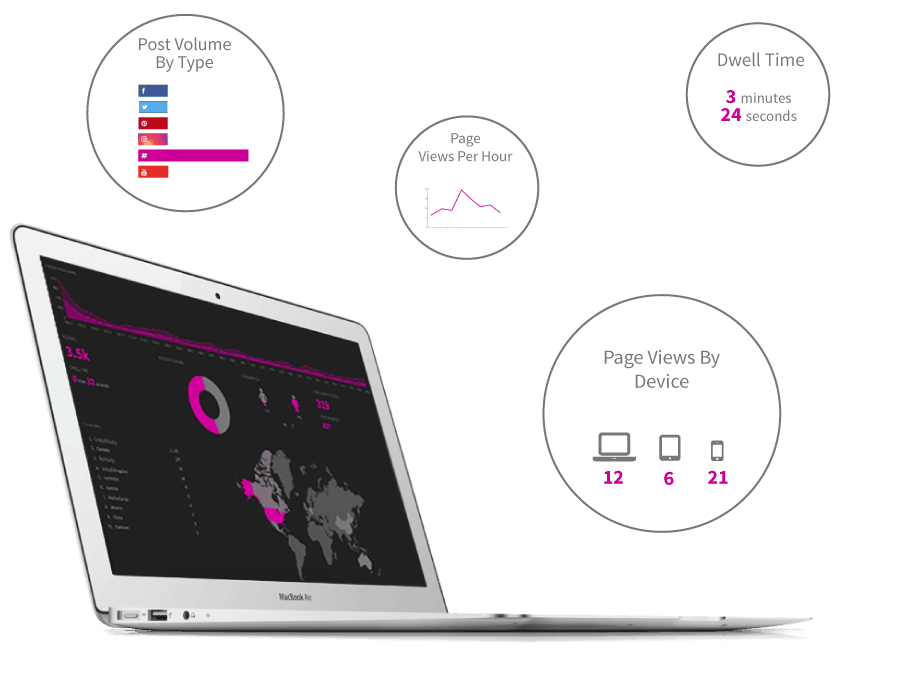The Ultimate Guide to UGC Marketing

So, what exactly is UGC? How is it being used away from the social media networks where it originates? How can this help grow online businesses? And can we accurately measure its effect? These are a few of the key questions we’ll be addressing in this blog. We’ll also be providing a few pointers to help you get to grips with UGC yourself.

What is UGC?
First things first, let’s just agree on what UGC is. By definition User Generated Content is exactly what it says on the tin – content created by end users of a social media network, usually in response to a particular hashtag conversation. That hashtag conversation e.g. #welovecoffee might have been started by an individual. Or it might have been started by a company’s marketing team to generate a conversation around a specific marketing campaign. The end result is the same. Like minded people from all over the world could use the #welovecoffee hashtag. Why? But of course to attach their thoughts, images and videos to a common thread of a conversation about great coffee.

The Role of UGC in Marketing
Marketeers running digital marketing campaigns understand the importance of quality content. Good content attracts people. It makes them more likely to talk about and share your brand with others.
Traditionally marketers would have generated that content themselves, either in house or more often via an external creative agency. Today, that may still be the case for many campaigns. However, with the advent of social media, and hashtag adoption, some of that strain can be taken by UGC.
Imagine this scenario. ACME Travel wants to produce a digital campaign about visiting Paris. They could spend their budget (and quite a lot of time) commissioning an agency to create copy, images and or video for their new ‘Paris Rocks’ marketing campaign. Job done. That’s great and it’s the way it’s always been done. But these days it’s not the only show in town… Earned UGC content could have been used very effectively here.
User Generated Content is the King in Content Marketing
There’s more and more evidence to suggest that user-generated content (UGC) is the king in the current content marketing climate. Especially given people’s growing awareness of how traditional marketing and advertising works, or rather, doesn’t work.
However, just because content is user generated it doesn’t mean it’s always going to perform the way that you want. Given the sheer volume of UGC out there, how exactly can brands ensure that the content they incorporate into their marketing campaigns will resonate with their target audience? How will it drive greater engagement and, ultimately, higher conversions?
Following from this, we’ve put together a list of focus areas/ KPIs to help you evaluate the quality of your UGC marketing. It’ll also help you evaluate its subsequent effectiveness to help maximize the return of your investment in your marketing channels. In short, if the content is performing well on social media networks it’s a good indication that it will perform well on other marketing channels (websites, digital signage, emails and paid advertising).

A New Marketing Approach – Getting User Generated Content…
Think about it. It’s really quite beautiful. ACME Travel could have collected comments, reviews, images and video from people who have been to Paris already. People that love it for the same reasons that ACME think you should love it! And all that instead of spending lots of money and time with an external agency. So, instead of creating content from scratch ACME can get authentic traveller content within a few clicks of the mouse…
The Benefits of UGC marketing campaign
- the content is always available and always fresh and relevant
- there’s a never ending stream of people visiting Paris and talking passionately about it on social media
- it’s free.
But wait, the good news doesn’t end there!
- It turns out that potential customers trust more easily content produced by other members of the public.
Especially when you compare how much they believe brand produced content. It’s that old authenticity thing again… Everyday people with no particular agenda say it’s good and so it probably is. The wisdom of crowds as James Surowiecki might say.
3 Tips to Make Your UGC Marketing Campaign Flying High
Until relatively recently, UGC was mainly found on the social media networks themselves. That’s where individuals started using hashtags and so the brands followed suit.
Social media is great for getting the word out there and making submitting content easy for users. It has though one fatal flaw as a “platform” for showcasing UGC. It moves very quickly. This means that a successful campaign generating mountains for great UGC last week, can be invisible in a fortnight’s time.


1. Cultivating engagement
‘Engagement’ might be considered a slightly tricky benefit to nail down. Particularly when it comes to proving return on investment (ROI). But the benefit is one which the majority of marketers recognise as a key performance indicator for their digital campaigns. More engagement means more publicity for a brand, more return visitors to a website, better brand loyalty, brand awareness, more recommendations. And that’s just the tip of the iceberg.

- 84% of millennials claim the presence of UGC on websites has an influence on what they buy.
- 51% of US users trust UGC more than other content on a company’s website.
- According to Adweek, websites with UGC achieve a 29% higher conversion rate than those without it.
-
Banishing bounce
The content you produce will do the same job as UGC when it comes to getting visitors visiting your website. Both forms of content can serve as clickbait and increase search engine visibility. But UGC has been shown to make visitors stick around for much longer than standard content created by a brand. This has a very positive effect on bounce rate:
- Using hashtag competitions to generate UGC through social media can lead to a 10% decrease in bounce rate.

-
Measure the results
Lowering bounce rate and improving engagement may be important KPIs for a brand. But they’re important for one crucial reason. The real, measurable effect they have on sales and leads. Here too, UGC comes into its own as a conversion driving tool. Not everyone agrees on exact figures, but there is consensus that UGC has a very positive effect on conversion.
- eCommerce clients who interact with a user generated customer photo on a site are 9.6% more likely to convert.
- 63% of shoppers trust customer photos more than brand or retailer photos.
- Featuring UGC at the point of purchase increases sales conversions by 7%.

Which KPIs matter in UGC marketing?
-
Impressions
Impressions are an old-school marketing metric that still remains important today. It’s providing an indication of how far-reaching a piece of content is. The number of impressions is by no means the be-all and end-all for UGC marketing. However, it’s a good measurement for quality, with highly engaging/ relevant content appearing more frequently in other people’s news feed. Everything ofcourse due to the structuring of the various social media network algorithms.
-
Clicks
Seeing how frequently people click on content on the various social media networks is generally a good metric. It’s especially good to help measure the quality of the content. More clicked posts are normally reflective of more compelling and effective UGC marketing. It can, however, be dangerous to look at this number in isolation. Highly clicked content with a low like and share rate could indicate that a particular piece of content is able to demand the initial attention of an audience. However, it then fails to deliver the expected quality.
Likes & Shares
Most of the major social media networks like Twitter, Facebook and Instagram have the option to like and share content. This number is probably the quickest and easiest way to gauge the quality of social content. Likes and shares show a clear intent of people connecting with and enjoying a particular piece of content. This is comes as a contrast with viewing clicks alone. And whilst we almost always welcome likes, sharing content shows a significantly stronger sentiment. People are recognising the quality of the content and actively recommending it.
-
Comments
As a general rule of thumb, interesting and relevant content sparks conversation. Therefore, if a post is generating a lot of comments it’s a reliable sign that it’s hitting the right spots. It would be pretty effective if integrated into your other marketing channels. Similar to likes and shares, commenting also shows a clear intent. People are connecting with the content in some way or another. However as comments can be negative as well as positive, it’s probably not as clear of an indication of quality content as the previously mentioned.
-
Post Source
In some but not all cases, we consider users who’ve built up large audiences on social media as ‘Social Influencers’. This is happening due to both the extent of their audience size and engagement. More often than not, these influencers are popular by having a good understanding of what makes effective and quality content. Having a look at whoever produced or shared a piece of content can be a worthwhile consideration. Particularly if they have a strong social presence, they act as a second opinion or sanity check evaluating your UGC.
-
What’s Trending
The timing and subsequent relevancy of UGC is directly related to how well it will perform for you. Especially given the pace and sheer volume of content that people faced on a daily basis. A good way to get a feel for what’s popular and relevant at the time is by looking at the number of people mentioning/ tagging a particular topic or posting to a hashtag. The more people interacting with a hashtag or mention at a given time, generally the more relevant it will be. Moreover, it’s likely that the related piece of content will positively resonate with its target audience.
Putting It All Together With Miappi Performance Predictions
Gaining an understanding for these metrics to help you better judge the quality of social content is the easy part. The difficulty lies in getting all of your social KPIs in one place to analyse and compare your social content. This is happening due to the sheer volume of content you might have to sift through. In addition to the fragmented nature of social media platforms, finding your very best UGC is a painstakingly long. It’s a difficult process even with a social aggregation tool.
Realising this problem has lead us to start developing our Miappi Performance Predictions feature. This latest feature from Miappi blends our range of AI tools with all of the key social content metrics. The reasoning behind this is to gauge the extent to which posts are performing on social media.
Miappi Performance Predictions is a foolproof solution to overcoming the noise on social media. It’s crucial in discovering high quality, high converting posts that will boost engagement. Given that the posts are used throughout your marketing channels. And all that with the ability to process tens of thousands of social media posts each day. The magic lies in filtering and matching each post to your pre set criteria.

How to incorporate UGC into your website?
So how can brands collect and curate all of this lovely, valuable UGC. How can they consequently present it in the right places on their website? With several social channels acting as a UGC source, how can they unify it and clearly present it on site?
It may sound like a big, complex task, but a new raft of tools is emerging to make the job simple. Social media aggregators, are providing a powerful way for brands to share UGC in one unified on site spot.
These aggregators allow brands to reap the benefits of UGC easily. All that by simply turning social UGC into a website hosted “wall” which gathers curates, displays and moderates content. They’re able to boost engagement, reduce bounce and – yes – maximise conversions.
Would you like to learn more about using Miappi’s smart social media aggregation tool? Would you like to get the most from your user generated content? REQUEST A DEMO today from our helpful team.



